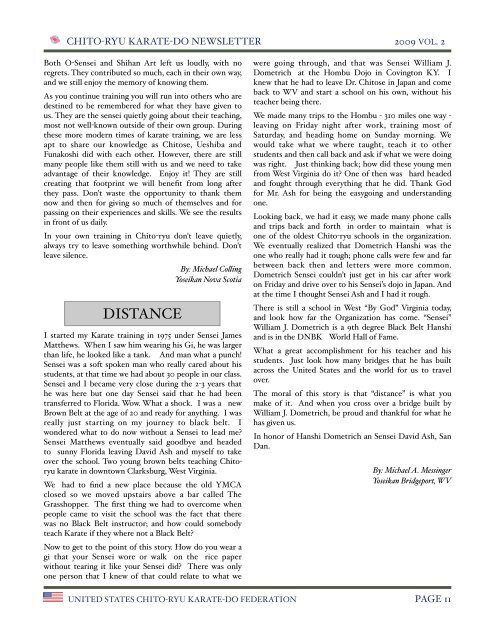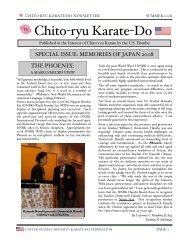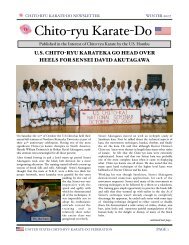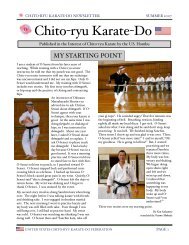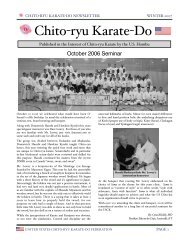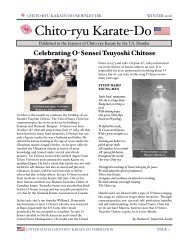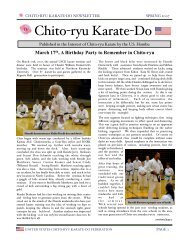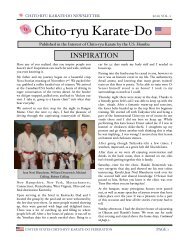2009 Volume 3 - United States Chito-ryu Karate Federation
2009 Volume 3 - United States Chito-ryu Karate Federation
2009 Volume 3 - United States Chito-ryu Karate Federation
You also want an ePaper? Increase the reach of your titles
YUMPU automatically turns print PDFs into web optimized ePapers that Google loves.
CHITO-RYU KARATE-DO NEWSLETTER <strong>2009</strong> VOL. 2<br />
Both O-Sensei and Shihan Art left us loudly, with no<br />
regrets. They contributed so much, each in their own way,<br />
and we still enjoy the memory of knowing them.<br />
As you continue training you will run into others who are<br />
destined to be remembered for what they have given to<br />
us. They are the sensei quietly going about their teaching,<br />
most not well-known outside of their own group. During<br />
these more modern times of karate training, we are less<br />
apt to share our knowledge as <strong>Chito</strong>se, Ueshiba and<br />
Funakoshi did with each other. However, there are still<br />
many people like them still with us and we need to take<br />
advantage of their knowledge. Enjoy it! They are still<br />
creating that footprint we will benefit from long after<br />
they pass. Don't waste the opportunity to thank them<br />
now and then for giving so much of themselves and for<br />
passing on their experiences and skills. We see the results<br />
in front of us daily.<br />
In your own training in <strong>Chito</strong>-<strong>ryu</strong> don't leave quietly,<br />
always try to leave something worthwhile behind. Don't<br />
leave silence.<br />
DISTANCE<br />
By: Michael Co!ing<br />
Yoseikan Nova Scotia<br />
I started my <strong>Karate</strong> training in 1975 under Sensei James<br />
Matthews. When I saw him wearing his Gi, he was larger<br />
than life, he looked like a tank. And man what a punch!<br />
Sensei was a soft spoken man who really cared about his<br />
students, at that time we had about 30 people in our class.<br />
Sensei and I became very close during the 2-3 years that<br />
he was here but one day Sensei said that he had been<br />
transferred to Florida. Wow. What a shock. I was a new<br />
Brown Belt at the age of 20 and ready for anything. I was<br />
really just starting on my journey to black belt. I<br />
wondered what to do now without a Sensei to lead me?<br />
Sensei Matthews eventually said goodbye and headed<br />
to sunny Florida leaving David Ash and myself to take<br />
over the school. Two young brown belts teaching <strong>Chito</strong><strong>ryu</strong><br />
karate in downtown Clarksburg, West Virginia.<br />
We had to find a new place because the old YMCA<br />
closed so we moved upstairs above a bar called The<br />
Grasshopper. The first thing we had to overcome when<br />
people came to visit the school was the fact that there<br />
was no Black Belt instructor; and how could somebody<br />
teach <strong>Karate</strong> if they where not a Black Belt?<br />
Now to get to the point of this story. How do you wear a<br />
gi that your Sensei wore or walk on the rice paper<br />
without tearing it like your Sensei did? There was only<br />
one person that I knew of that could relate to what we<br />
were going through, and that was Sensei William J.<br />
Dometrich at the Hombu Dojo in Covington KY. I<br />
knew that he had to leave Dr. <strong>Chito</strong>se in Japan and come<br />
back to WV and start a school on his own, without his<br />
teacher being there.<br />
We made many trips to the Hombu - 310 miles one way -<br />
leaving on Friday night after work, training most of<br />
Saturday, and heading home on Sunday morning. We<br />
would take what we where taught, teach it to other<br />
students and then call back and ask if what we were doing<br />
was right. Just thinking back; how did these young men<br />
from West Virginia do it? One of then was hard headed<br />
and fought through everything that he did. Thank God<br />
for Mr. Ash for being the easygoing and understanding<br />
one.<br />
Looking back, we had it easy, we made many phone calls<br />
and trips back and forth in order to maintain what is<br />
one of the oldest <strong>Chito</strong>-<strong>ryu</strong> schools in the organization.<br />
We eventually realized that Dometrich Hanshi was the<br />
one who really had it tough; phone calls were few and far<br />
between back then and letters were more common.<br />
Dometrich Sensei couldn’t just get in his car after work<br />
on Friday and drive over to his Sensei’s dojo in Japan. And<br />
at the time I thought Sensei Ash and I had it rough.<br />
There is still a school in West “By God” Virginia today,<br />
and look how far the Organization has come. “Sensei”<br />
William J. Dometrich is a 9th degree Black Belt Hanshi<br />
and is in the DNBK World Hall of Fame.<br />
What a great accomplishment for his teacher and his<br />
students. Just look how many bridges that he has built<br />
across the <strong>United</strong> <strong>States</strong> and the world for us to travel<br />
over.<br />
The moral of this story is that “distance” is what you<br />
make of it. And when you cross over a bridge built by<br />
William J. Dometrich, be proud and thankful for what he<br />
has given us.<br />
In honor of Hanshi Dometrich an Sensei David Ash, San<br />
Dan.<br />
By: Michael A. Messinger<br />
Yoseikan Bridgeport, WV<br />
UNITED STATES CHITO-RYU KARATE-DO FEDERATION PAGE 11


